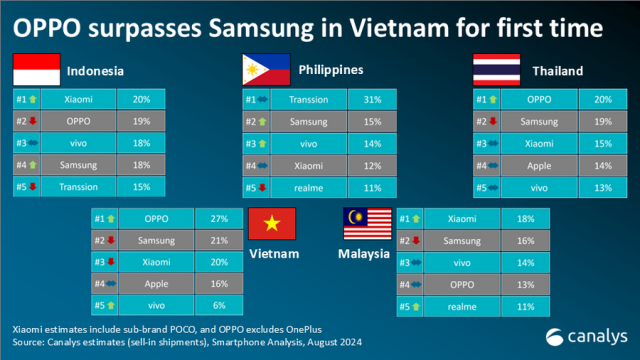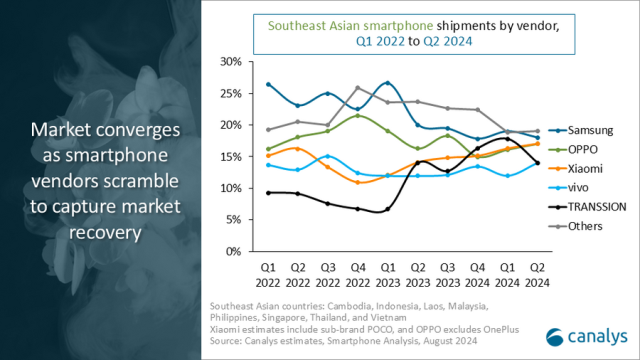Research team at Canalys has revealed smartphone share of top players in Indonesia, Philippines, Thailand, Vietnam and Malaysia – key countries in Southeast Asia.

Canalys said Southeast Asia smartphone shipments rose 14 percent in Q2 2024 to 23.9 million units.
Xiaomi is the leader in the smartphone market in Indonesia with 20 percent share followed by Oppo with 19 percent; Vivo with 18 percent; Samsung with 18 percent; and Transsion with 15 percent.
Transsion is the leader in the smartphone market in the Philippines with 31 percent share followed by Samsung with 15 percent; Vivo with 14 percent; Xiaomi with 12 percent; and Realme with 11 percent.
Oppo is the leader in the smartphone market in Thailand with 20 percent share followed by Samsung with 19 percent; Xiaomi with 15 percent; Apple with 14 percent; and Vivo with 13 percent.
Oppo is the leader in the smartphone market in Vietnam with 27 percent share followed by Samsung with 21 percent; Xiaomi with 20 percent; Apple with 16 percent; and Vivo with 6 percent.
Xiaomi is the leader in the smartphone market in Malaysia with 18 percent share followed by Samsung with 16 percent; Vivo with 14 percent; Oppo with 13 percent; and Realme with 11 percent.
Southeast Asia market

Samsung saw a slight recovery after seven consecutive quarters of year-on-year decline, shipping 4.4 million units and capturing 18 percent market share.
OPPO (excluding OnePlus) reclaimed second position, shipping 4.2 million units for a market share of 17 percent.
In third place, Xiaomi’s push in the low end saw it close the gap with 4.0 million units and a market share of 17 percent.
Vivo recaptured fourth spot with 3.4 million units and 14 percent market share.
TRANSSION’s shipments slowed after a Q1 spike, finishing fifth with a 3.3 million shipment and a market share of 14 percent.
Canalys Analyst Le Xuan Chiew said smartphone vendors are optimizing product pricing strategies to capture the rebound. In the mass market segment, Xiaomi and TRANSSION lead with aggressive pricing and sales incentives, capitalizing on the region’s price sensitivity.
Xiaomi is expanding its channel presence. In Malaysia, according to Canalys’ monthly tracker, Xiaomi’s telco shipments have grown significantly since April, as it listed devices across all major telcos for the first time, driving volume with the affordable Redmi 13C 5G to align with government efforts to drive 5G devices to the masses.
OPPO, in addition to launching its A60 in the US$100-200 price segment, enhanced its presence in the mid-to-high-end market by introducing the Reno12 series and brought the popular A3 Pro series from mainland China to the Southeast Asian market.
Vivo’s dual-band strategy, with the Y03 for low-end and the V-series for mid-high segments, ensures healthy growth and a balanced product mix.
Vendor investment to develop high-end retail channels and experience stores in the region seems to be yielding positive results, with the premium segment seeing growth. The premium (above US$600) segment has grown 18 percent from 4.3 million units in H1 2023 to 5.1 million units in H1 2024.
Samsung has realigned its global strategy with laser focus on the high-end market. By investing heavily in marketing and creating exclusive pop-up events to showcase its AI capabilities, the company aims to enhance consumer awareness and drive device upgrades.
Apple grew 15 percent versus its H1 2023 results by expanding retail efforts in Vietnam and Malaysia, aggressive marketing, and Tim Cook’s Southeast Asia tour.
